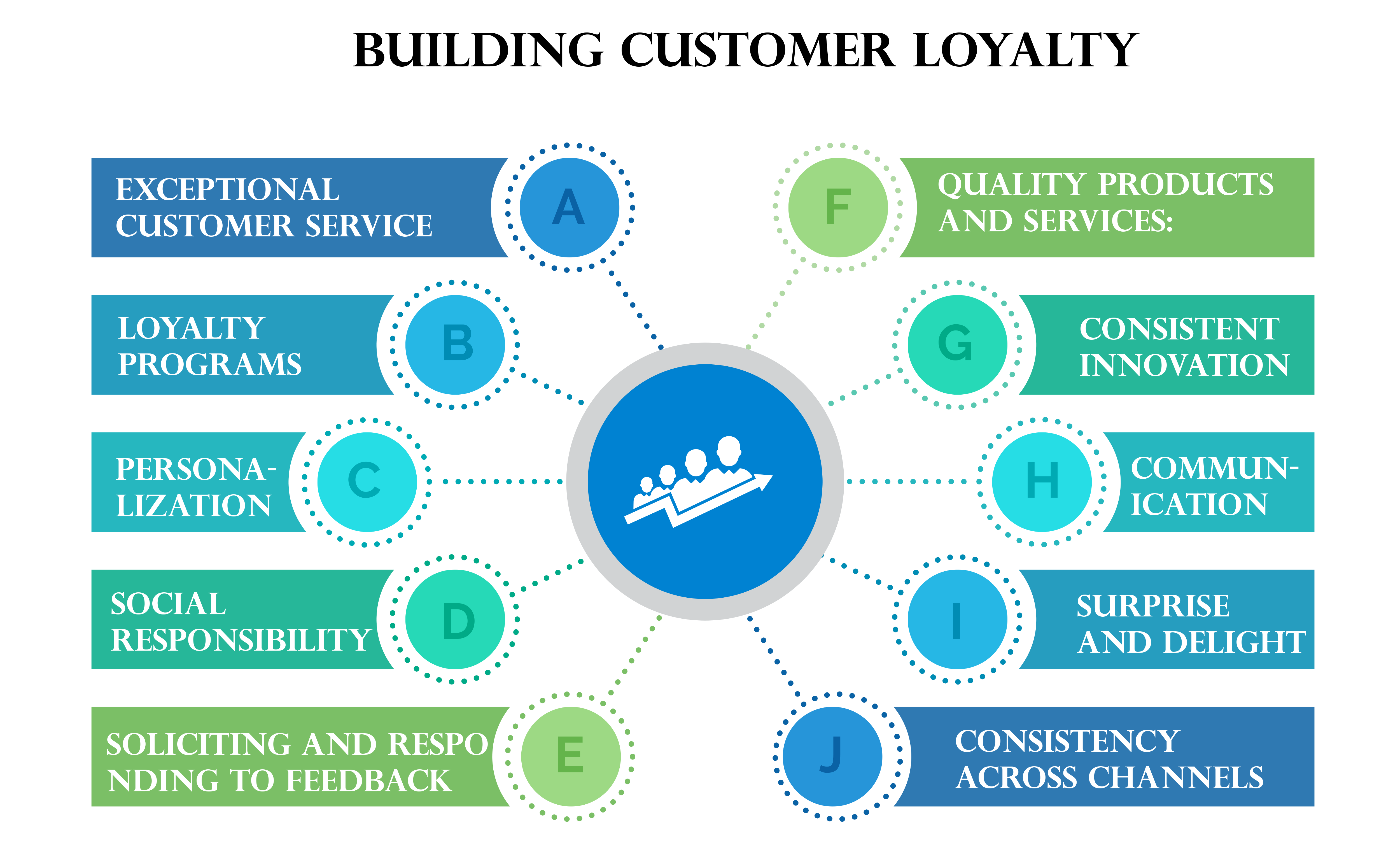CUSTOMER BEHAVIOR
I. WHAT IS THE CUSTOMER BEHAVIOR ?
Consumer behaviour refers to the activities and decisions that individuals or households make while selecting, purchasing, using, and disposing of a product or service. Many psychological, social, and cultural factors influence how consumers interact with the market.
Individuals or groups’ behaviours, decisions, and responses while interacting with products, services, brands, or enterprises are referred to as customer behaviour. It refers to the behaviours and thinking processes that customers engage in before, during, and after completing a purchase. Understanding client behaviour is critical for organisations in order to properly customise their marketing tactics, product offers, and customer experiences.
Here are 5 major factors that influence consumer behavior:
Psychological Factors
Social Factors
Personal Factors
Economic Factors
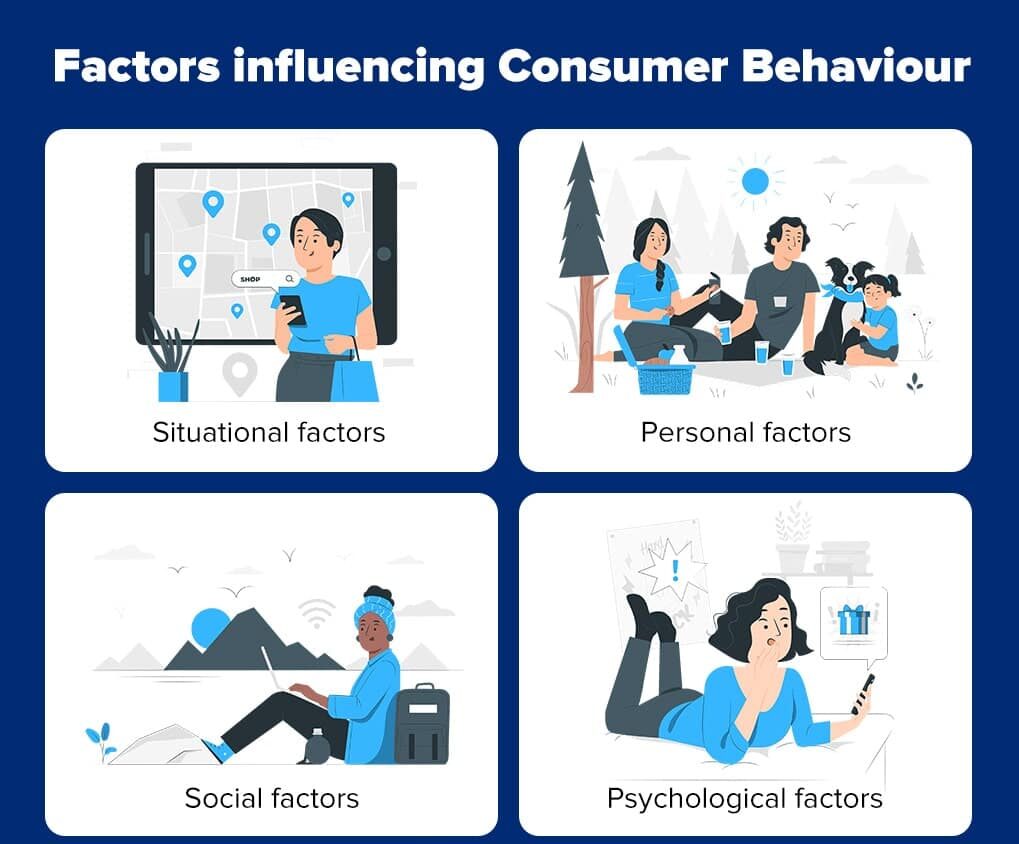
1 . PSYCHOLOGICAL FACTORS
A range of psychological variables impact consumer behaviour, shaping how people make decisions and engage with products and services. Here are some key psychological factors that play a role in influencing consumer behavior:
A. Perception :
Perception is how people understand and make sense of the stimuli around them. It comprises their perceptions of product or brand aspects, features, and qualities. Marketers frequently focus on developing good views in order to influence customer decisions.
Perception is a fundamental psychological process in which people evaluate and make meaning of the sensory information they receive from their surroundings. It has a significant impact on customer behaviour and how they engage with products, companies, and marketing messages.
Perception begins with sensory inputs received through our five senses: sight, hearing, touch, taste, and smell. These sensory inputs come from the outside world and give raw data for our brain to analyse.
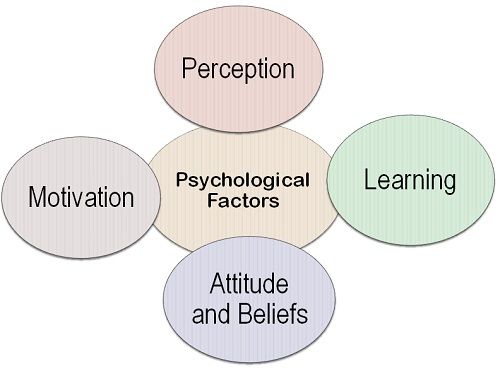
Not all sensory information is treated similarly. Selective attention entails concentrating on particular stimuli while ignoring others. Consumers are drawn to stimuli that are related to their wants, interests, or current circumstances.
Following selective attention, the brain integrates sensory information and assigns meaning to it. The process of adding importance and context to stimuli is known as interpretation. This is where the brain interprets what it is seeing.
B. Motivation :
Consumer behaviour is greatly influenced by motivation, a key component. It refers to the inborn motivations that push people to engage in specific actions, including choosing what to buy.
When a person is motivated enough, it influences the buying behavior of the person. A person has many needs such as social needs, basic needs, security needs, esteem needs, and self-actualization needs. Out of all these needs, the basic needs and security needs take a position above all other needs. Hence basic needs and security needs have the power to motivate a consumer to buy products and services. Motivation can be categorized into two main types, intrinsic and extrinsic.
Personal happiness, enjoyment, or a sense of success are the main sources of intrinsic motivation, which originates from inside the individual. A customer could decide to purchase a fitness tracker, for instance, because it supports their decision to live a healthy lifestyle. On the other hand, extrinsic motivation is motivated by outside elements like promotions, recognition, or social standing. Luxury goods may be bought by consumers to display their financial position.
C. Learning :
Learning is a significant factor that influences consumer behavior. It involves a process through which people pick up information, expertise, and experience with goods, services, and brands. Learning may have a significant influence on how customers perceive, assess, and decide what to buy. Cognitive learning and behavioural learning are the two basic learning styles that influence consumer behaviour.
Cognitive Learning:
Thinking, logical reasoning, and problem-solving are all involved in gaining knowledge and information. Consumers get knowledge about items through research, choice comparison, and feature evaluation. By supplying consumers with accurate and comprehensible product information, employing instructional materials, and giving thorough comparisons to aid in decision-making, marketers may have an impact on cognitive learning.
Behavioral Learning:
The foundation for this kind of learning is experience and discernible behaviour. Customers pick up knowledge via their experiences with goods and services as well as from comments and results. Positive brand experiences, for instance, might encourage repeat business and brand loyalty, whilst poor brand experiences may put off potential consumers.
D. Attitudes and Beliefs
Consumers hold specific attitudes and ideas, which have an impact on their purchasing decisions. The consumer behaves a certain manner towards a product based on this mentality. The brand image of a product is significantly influenced by this mentality. Therefore, in order to build their marketing strategies, marketers work very hard to comprehend customer attitudes.
An individual’s sentiments, ideas, and behavioural inclinations towards a certain good, service, or brand are combined to form their attitudes. Positive attitudes can boost brand loyalty and improve the possibility that a customer will make a purchase, but negative attitudes might discourage customers from using a product.
Beliefs are people’s knowledge and viewpoints about a service or company. These beliefs are developed from a variety of sources, including firsthand knowledge, secondhand information, advertising, and internet reviews. By giving customers factual information that is appealing and in line with their wants and aspirations, marketers may affect consumer opinions.
consumer behavior can be influenced through attitudes and beliefs by using Brand Messaging, Social Proof, Consistency, Educational Content, Emotional Appeal, and the Perceived Value.
2. PSYCHOLOGICAL FACTORS
Humans are social beings and they live around many people who influence their buying behavior. Humans attempt to mimic other people and also want to fit in with society. Their purchasing decisions are therefore impacted by others around them. These factors are considered as social factors. Some of the social factors are Family, Reference Group, Roles and status.

A. Family
Family is an important social component that has a big impact on how people behave in the marketplace. An individual’s views, tastes, and purchasing decisions are primarily influenced by the family unit, which also acts as a key source of socialisation and values. There are some ways that family might be affect buying habits such as Roles and Responsibilities, Decision-Making, Socialization, Influence on Children, Purchase Patterns, Cultural and Social Norms, ncome and Budgeting, Inter-Generational Influence, Family Life Cycle, and Media Consumption.
Different family members may have distinct roles and duties. These positions may have an impact on purchase choices. For instance, parents may decide on significant expenditures for the family, but kids may have a vote on items that directly impact them, such as toys or clothing.
Family members frequently decide on purchases together through shared decision-making procedures. Consensus-seeking and compromises may result from this. Different bargaining strategies and preferences may be taken into account depending on how family members interact with one another.
Families play a significant role in socializing individuals. The values, beliefs, and cultural norms learned within the family unit can impact how consumers perceive brands and products. These shared values can influence brand loyalty and the types of products a family chooses to buy.
Children are particularly susceptible to family influence. Parents’ preferences, behaviors, and choices can heavily shape their children’s consumer preferences. Children often seek approval from their parents and might model their consumption patterns based on their family’s behaviors.
Family size and composition can affect purchasing decisions. Larger families may buy products in bulk or opt for value packs, while smaller families might prioritize convenience and smaller quantities.
Families transmit cultural norms and traditions that can impact consumer behavior. Certain cultures may prioritize gift-giving during specific holidays, leading to increased consumption during those periods.
B. Reference Groups
A reference group is a group of people with whom a person associates himself. Generally, all the people in the reference group have common buying behavior and influence each other.
Reference groups are social organisations that people use to assess their attitudes, convictions, and actions. These groups might be direct (conversing in person) or indirect (representing aspirational organisations that people respect).
People frequently adopt the customs and conduct of their reference groups. To blend in with and be accepted by their chosen group, they could purchase goods or adopt particular behaviours. Teenagers, for instance, could imitate their friends’ or favourite celebrities’ dress choices.
People construct their social identities with the aid of reference groups. Products that fit with a person’s intended group membership and self-concept are chosen by consumers. Their consumption of goods becomes a means of expressing their identity, values, and worldview. For instance, a person can decide to purchase specific clothes labels in order to associate themselves with a given social group. Even if they don’t connect directly, those who belong to aspirational reference groups nonetheless want to be a part of them or identify with them. In an effort to improve their social standing or self-image, people may seek out things or behaviours that are associated with these groups.
There are frequently influential or opinion-leading individuals inside reference groups. Their recommendations and decisions may influence others’ preferences. These thought influencers are frequently the focus of marketing campaigns to promote goods and services.
C. Roles and status
Roles and status are fundamental social characteristics that have a big impact on how people behave in the marketplace. These elements are linked to a person’s place in society, the duties that come with that place, and the respect and perceived status that are attributed to that place. The status and income of a person are frequently correlated with their function in society. others in high-status jobs could have more spare cash and be more inclined to indulge in luxuries, whereas others in low-status positions might prioritise utilitarian purchases.
High-status people frequently utilise goods and services as emblems of their prestigious status. Luxury brands and high-end goods can be thought of as status symbols that enable people to flaunt their riches and success to others. People with greater status or in specific jobs may participate in conspicuous consumerism, purchasing goods and services that are obvious and highlight their status. This may entail expensive automobiles, trendy apparel, or cutting-edge technology.
Customers with various positions or statuses may favour particular brands that are consistent with how they view their social standing. Brands are more likely to catch their attention if they align with their beliefs and ideal image. Roles and status can affect the reference groups that people choose to identify with. People frequently gravitate towards organisations that share their social status and moral principles. The choices made by these groups can then influence a person’s consumption choices.
3. PERSONAL FACTORS
Personal factors, in psychology, refer to individual traits and traits that affect a person’s thoughts, feelings, and behaviors. These factors are unique to each person and can play an important role in shaping their personality and overall mental well-being. The personal factor is represented by self-construction, and gender, social environment, perceived social class, and family are represented by the social factors
Personal factors also play an important role in shaping consumer behavior. These factors are specific to each consumer and can vary greatly from person to person.
there is some personal factors that impact consumer behavior such as income, age, occupation, and lifestyle.
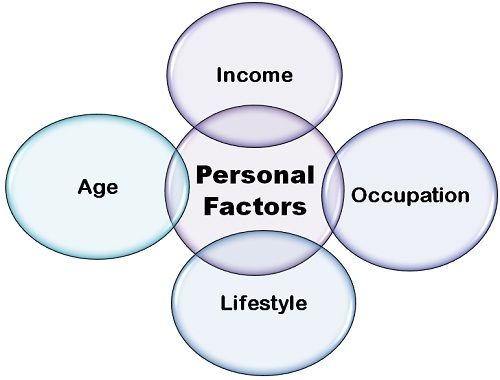
A. INCOME
Income is the money that a person or organization receives in exchange for their work or products.
Income is an important personal factor that can strongly influence consumer behavior. A person’s income level influences purchasing power, preferences and consumption habits.
The income effect identifies changes in consumer demand for goods and services as a function of their income. In general, as income increases, they will begin to demand more goods. Likewise, a drop in income leads to a drop in demand. income can influence consumer behavior by Purchasing Power, Product Choices, Brand Preferences, Quality vs. Price, Lifestyle and Aspirations, Savings and Investment, Consumer Durables, Social Status and Conspicuous Consumption, Promotions and Discounts
The quantity of money a person has available for spending is directly influenced by their income. People with higher incomes can afford more expensive goods and services, whereas those with lower incomes have fewer options. Consumers with higher earnings can buy more frequently and in larger quantities, but those with lesser incomes might need to set priorities and make more careful decisions.
B. AGE
Age is a significant element that can have a variety of effects on consumer behaviour. Age-related differences in preferences, attitudes, requirements, and buying habits can have a significant impact on consumers’ interactions with businesses and their purchasing decisions. Older consumers tend to have different product preferences compared to younger consumers. For instance, older consumers are more likely to value functionality, quality, and durability over aesthetics and brand names. They also prefer products that cater to their needs, such as health and wellness. Age can influence consumer behavior by Generational Differences, Technological Proficiency, Communication Preferences, Brand Loyalty, Buying Power, Lifestyle Changes, Social Trends, Media Consumption, Decision-Making Processes, Channel Preferences, Fashion and Trends.
Marketers need to be aware of these differences in order to effectively target and serve various age groups, and to modify their marketing tactics, messaging, and goods as necessary. It’s crucial to remember that these are merely generalisations and that within each age group, personal preferences might still differ significantly.
C. OCCUPATION
The consumer’s line of work affects their purchasing decisions. A person usually purchases items that are suitable for his or her line of work. For instance, a top corporate executive would typically purchase formal attire, whereas a creative designer would typically spend money on informal attire.
Another significant aspect that may have an impact on consumer behaviour is occupation. The income level, lifestyle, priorities, and tastes of an individual are frequently influenced by their line of work, all of which have an impact on the purchases they make. Here are some examples of how a job could affect buying decisions: Income Level, Lifestyle and Spending Patterns, Professional Identity, Work Environment, Social Status and Networking, Time Constraints, Technology Adoption, Professional Development, Travel Requirements, Job Satisfaction and Stress, Social Influence, Societal Perception.
It’s crucial to remember that there are various elements that influence customer behaviour in addition to occupation. To effectively target and engage various consumer segments, marketers must take into account a combination of demographic, psychographic, and behavioural factors. Marketers can build products and messages that are in line with the demands and preferences of various occupational groups by knowing how occupation effects consumer behaviour.
D. LIFESTYLE
It’s crucial to remember that there are various elements that influence customer behaviour in addition to occupation. To effectively target and engage various consumer segments, marketers must take into account a combination of demographic, psychographic, and behavioural factors. Marketers can build products and messages that are in line with the demands and preferences of various occupational groups by knowing how occupation effects consumer behaviour.
A key element that profoundly affects customer behaviour is lifestyle. Lifestyle includes a person’s attitudes, values, activities, interests, and opinions. All of these factors influence preferences and purchase decisions. Here are some ways that lifestyle can affect buying decisions: Product Preferences, Brands and Image, Purchase Motivations, Media and Communication Preferences, Shopping Habits, Social Interactions, Environmental Concerns, Entertainment and Leisure, Personal Identity, Social Media Influence, Value Systems, Time Allocation, Cultural Trends, Age and Life Stage.
Marketing professionals can better target their strategies, messaging, and product offerings to appeal to particular consumer categories by understanding the intricate interplay between lifestyle and consumer behaviour. Strong brand identity development and emotional and personal connections with customers through lifestyle alignment are essential to effective marketing.
II. THE CUSTOMER JOURNEY
The process that a consumer goes through when making a purchasing choice is referred to as the consumer journey, also known as the customer journey or buyer’s trip. From the first awareness of a product or need to the ultimate purchase and beyond, it involves different stages and touchpoints. Businesses must comprehend the consumer journey in order to interact with and influence customers in each stage.
A customer journey is a visual storyline of every engagement a customer has with a service, brand, or product. The creation of a journey map puts the organization directly in the mind of the consumer, so they can see and understand their customer’s processes, needs, and perceptions.
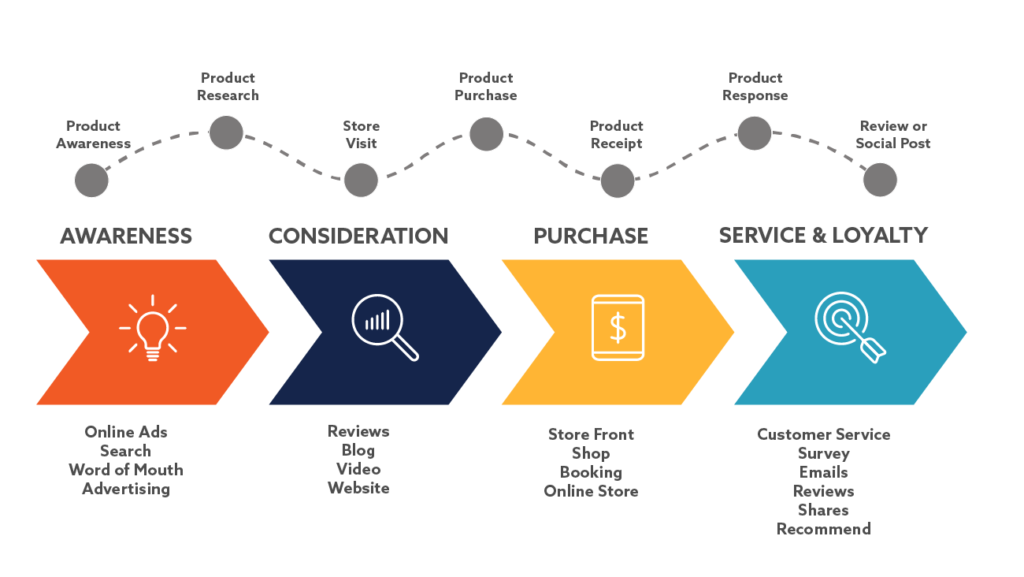
The following stages often make up the consumer journey:
A. AWARENESS
The main objective of the awareness stage of the consumer journey is to introduce and raise awareness of your brand, product, or service among potential customers. The first communication between your company and the target market occurs at this stage.
The consumer journey occurs in a series of steps during the awareness stage, starting with initial exposure to your brand or product. This piques their interest and curiosity, resulting in attention-getting strategies that draw them in. Engagement rises when customers demand more information, which promotes the growth of brand recognition. Trust is increased by educational content, and lead generation opportunities appear. As consumers advance, audience segmentation becomes possible, enabling focused strategies. Setting up clear expectations for your offering is crucial at this time and cannot be stressed.
B. CONSIDERATION
Consumers start looking into and investigating prospective solutions as soon as they become aware of their demand. They look for details regarding various goods, companies, attributes, and advantages. Online research, reading reviews, comparing options, and asking friends or professionals for ideas are all part of this stage.
Potential buyers are actively looking for more information about your product or service during the research and consideration stage of the consumer journey. As customers assess their options and contrast various solutions to meet their needs, this stage is critical.
People engage in a thorough process with many steps throughout the research and consideration stage. Beginning with alternatives, they compare and contrast each one in order to understand its advantages and disadvantages. In-depth research is required during this stage in order to fully understand the complexities and subtleties of the options available while regularly assessing their applicability to particular requirements. It is essential to acquire information and compare the value propositions being presented carefully. As potential consumers look to the experiences of others for assurance, social proof is important. In this process, it is crucial to address concerns and accept trade-offs in order to foster trust. Individuals develop a comprehensive understanding through the consumption of pertinent content, engagement with brands, and exploration of user experiences, progressively whittling down their options to the best ones.
C. PURCHASSE
This phase is also known as the decision phase. The customer has completed their decision-making process, compared your brand to the competition, and is prepared to buy. Being as open and honest about prices at this point is beneficial.
Potential customers have finished their research, weighed their options, and are now prepared to make a decision during the buy stage of the consumer experience. At this point, the real transaction is made, and the customer moves from considering possibilities to deciding on a certain good or service.
To ensure a seamless and comfortable purchasing process, numerous key actions take place during the purchase stage. Consumers first examine their choices and preferences during the decision-making process. Once a decision has been made, the following step is to choose the best buying channel, whether it be online or in-store. The transaction then occurs, including payment processes that are frequently enhanced by discounts and promotions.
The discussion then moves to shipping and delivery arrangements, followed by confirmations to finalise the purchase. Receipts and invoices are used to keep an extensive record. Businesses frequently use this phase to cross-sell and upsell related products. Through customer reviews, feedback becomes more prominent, assisting both businesses and potential customers. Customer satisfaction is increased by post-purchase contact, including order tracking and customer support. Membership programmes and other loyalty benefits offer value and promote enduring relationships. A holistic shopping experience is guaranteed by this method.
D. LOYALTY
The Loyalty stage is your final opportunity to accomplish that and learn how to take your connections beyond the fundamentals into advocacy and growth. The actions that foster loyalty should be the main focus of this stage of the customer journey map
The first purchase is less important during the loyalty phase of the customer experience since attention is now directed towards building and sustaining a long-term bond between the client and the company. This stage tries to convert one-time customers into devoted supporters who routinely pick the brand’s goods or services over rivals.
The consumer journey’s loyalty phase is made up of a number of crucial activities and tactics designed to forge long-lasting bonds between consumers and businesses. At its centre are Membership or Loyalty Programmes that give customers exclusive benefits and foster loyalty. Personalised Engagement strengthens this bond by customising experiences to fit each person’s preferences. Brands maintain consumer engagement by communicating often with them and informing them about new products and promotions.
A deeper level of appreciation is added by the Surprise and Delight factor because unexpected acts of kindness produce enduring interactions. Exclusive Content gives devoted clients insider access and further enhances the experience. Brands actively look for feedback and improvements to show their dedication to enhancing their products in light of user insights. As devoted customers become brand ambassadors and spread great experiences, social proof and advocacy play a role. Retention campaigns work to reactivate dormant consumers, while community building helps similar-minded customers connect. In the end, Continuous Value serves as the foundation for this stage by ensuring that consumers consistently receive worthwhile benefits and develop enduring loyalty.
III. THE CUSTOMER SEGMENTATION
Customer segmentation is the practise of classifying customers of an organisation into groups based on shared traits so that organisations may promote to each group efficiently and properly.
Customer segmentation is an essential tactic used by firms to divide its clientele into different groups based on common traits, behaviours, demands, and preferences. This segmentation enables companies to customise their marketing initiatives, goods, and services to each group, leading to more effective communication, more client happiness, and better sales.
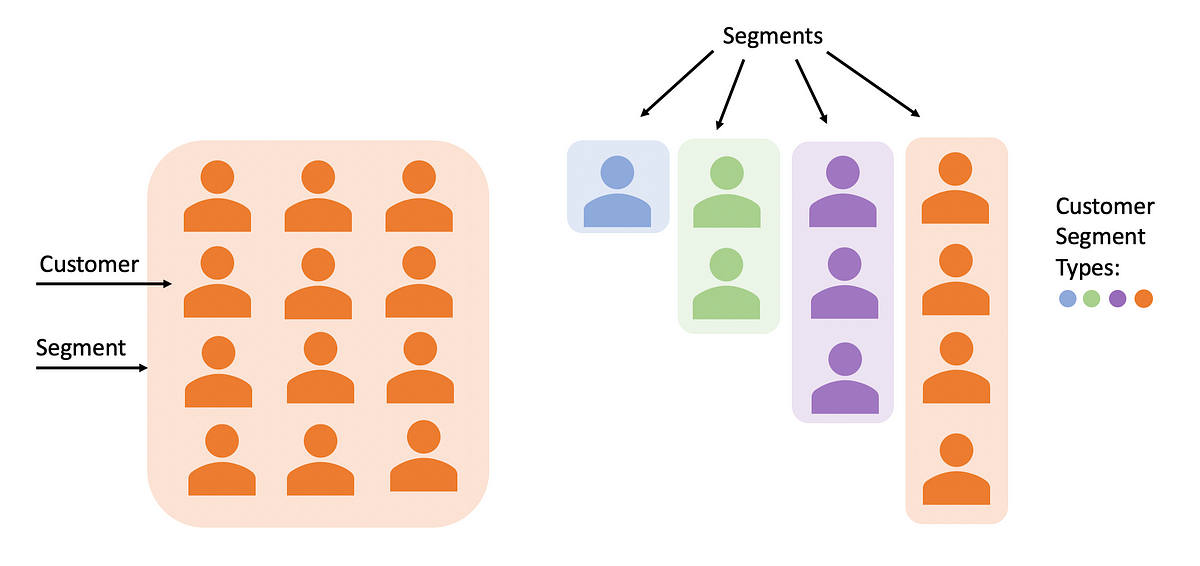
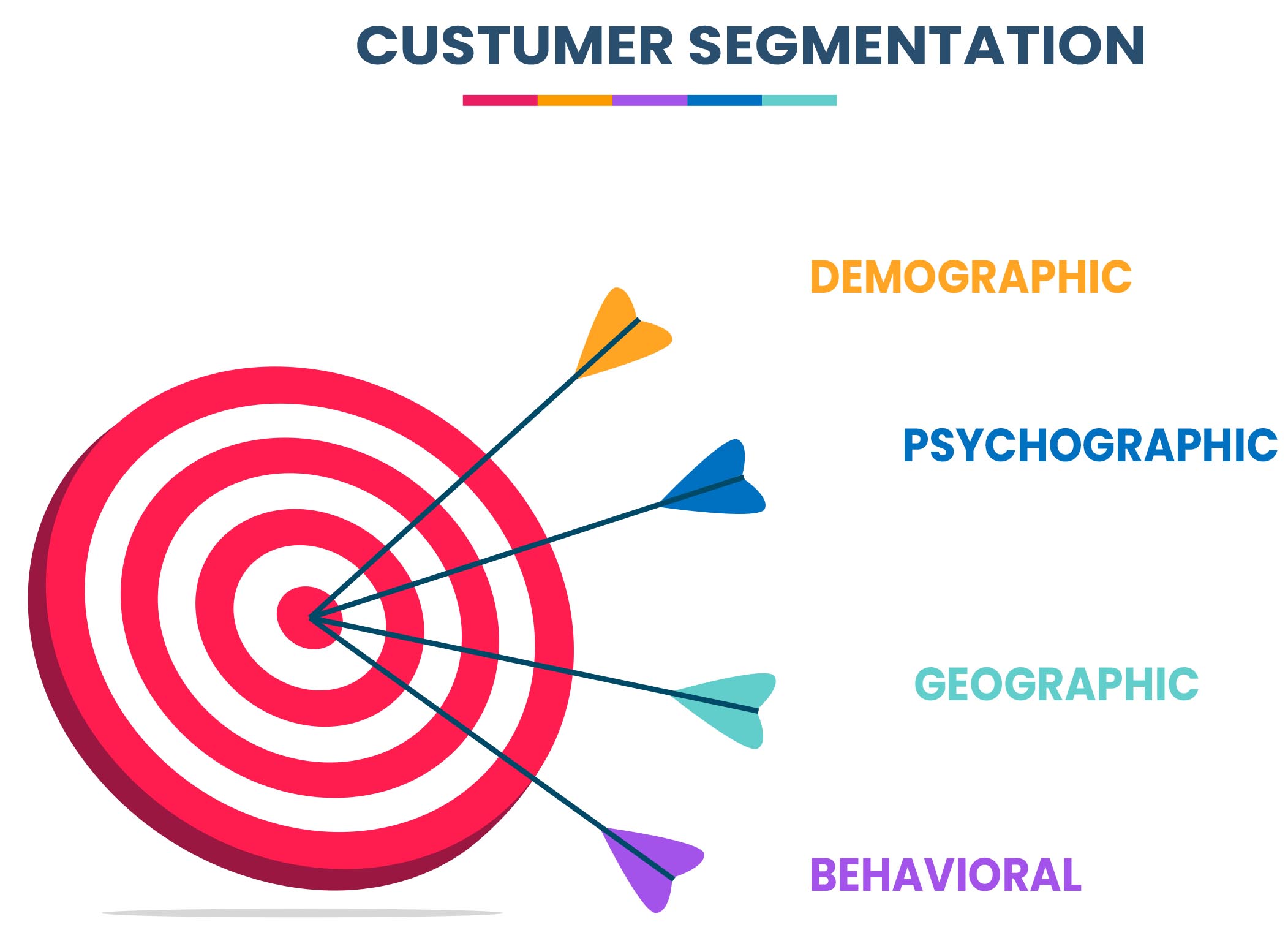
By giving businesses the knowledge they need to create goods that cater to the wants and preferences of the target market and boost the likelihood of a successful product launch, customer segmentation plays an essential role in product development. Four ways to segment markets include demographic, psychographic, behavioral, and geographic segmentation
A. Demographic segmentation
By splitting a consumer base into various categories according to demographic traits, demographic segmentation is accomplished. These traits are measurable and can offer important insights into the preferences, actions, and requirements of various client categories. Here are some important demographic traits that companies frequently consider when dividing up their clientele:
Businesses regularly use a variety of demographic indicators to categorise their consumer bases. Age, gender, household size, family size, ethnicity/culture, geography, language, generation/cohort, digital savvy, life stage, homeownership, and health and well-being are a few of these. Businesses may adapt marketing strategies, create niche goods, and provide improved customer experiences that fit particular demographic profiles by utilising these crucial demographic components to obtain deeper insights into customer preferences, behaviours, and needs.
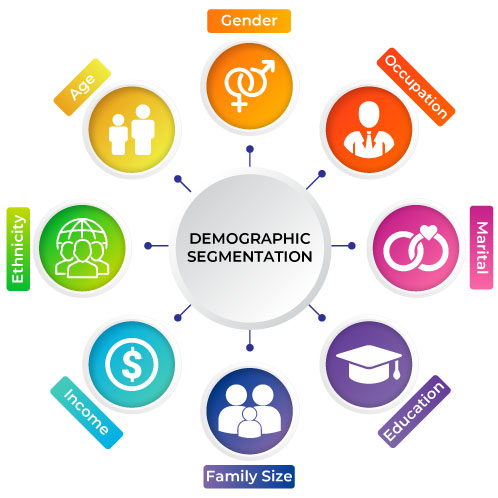
Through customer surveys, transaction records, internet interactions, and third-party data sources, businesses can collect demographic information about their clients. Businesses can produce more niche products, more effectively target marketing campaigns, and improve overall customer experiences by segmenting their consumer bases based on demographic traits. The combination of demographic segmentation with other types of segmentation (such as behavioural and psychographic) can help you gain a more complete picture of your consumer base, but it’s crucial to keep in mind that demographic segmentation is only one piece of the puzzle.
B. Psychographic segmentation
The research process known as psychographic segmentation is used to examine consumers and categorise them based on psychological traits such as personality, lifestyle, social status, activities, interests, opinions, and attitudes. Customer groups are identified based on their psychological and lifestyle characteristics through psychographic segmentation. This strategy takes into account elements like values, interests, personality traits, attitudes, and behaviours in addition to demographic information.
Psychographic segmentation is a tool that businesses may use to understand and successfully target various client segments depending on a variety of characteristics. Understanding customer values and beliefs enables businesses to appeal to those who hold similar beliefs. Businesses can create services that connect with customers’ interests by catering to Interests and Hobbies. Analysing Lifestyle and Behaviour aids in predicting preferences and needs, while Personality Traits allow businesses to customise products and marketing to diverse personalities. Companies can target customers that want luxury and exclusivity by using social class and status as well as attitudes and opinions to personalise items for particular viewpoints.,
Brand Loyalty and Advocacy concentrate resources on loyal customers and brand supporters, while Innovation allows businesses to present novel items to early adopters. Social influences direct peer-influenced marketing, identifying the benefits sought for enables targeted offers, and opinions on trends drive pertinent message. Finally, businesses can use emotional triggers to create advertisements that are compelling to the human heart. Businesses are enabled to deeply engage clients and create offers that authentically connect with their motivations and lifestyles by integrating these psychographic insights into their strategy.
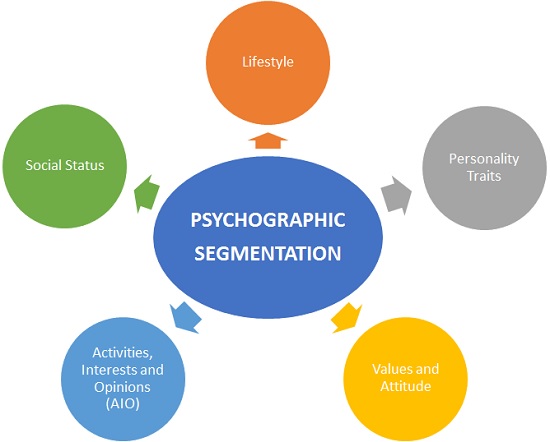
Surveys, social media analysis, customer feedback, and online behaviour tracking can all be used to gather psychographic data. A thorough understanding of client segments is obtained by combining psychographic segmentation with other segmentation techniques, including demographic and behavioural segmentation. With the help of this strategy, organisations can engage customers more deeply and create goods and marketing plans that are actually in line with the desires and lifestyles of their target markets.
C. Geographic segmentation
Geographic segmentation is the division of your population into various groups or classifications according on where they reside. In this kind of market segmentation, consumers are divided into groups according to their place of residence as well as variables like temperature, population, eating habits, clothing, etc. Customer groups are separated based on geography through geographic segmentation. The segmentation strategy takes into account the fact that a customer’s tastes, demands, and behaviours can change based on where they live.
Businesses can obtain insights into and strategically target various client segments by utilising geographic segmentation. Businesses can customise their offerings to suit with particular cultural quirks and market trends by taking into account elements like Country and Region. Companies can better cater to customers’ varying preferences and demands as a result of their different living areas by differentiating between urban and rural customers. Businesses can modify their product offers in response to seasonal demand and changing environmental circumstances thanks to segmentation that is based on climate and weather. Strategies that take into account differences between metropolitan and less densely populated areas are guided by population density insights. The ability to satisfy client preferences and availability to amenities is influenced by knowledge of city size.
Businesses can customise their messaging and products to appeal to local values by using segmentation that is based on cultural preferences. Companies can match promotions with the current interests of their clients by taking advantage of local events. By delivering content in clients’ preferred languages, language and communication considerations enable optimal engagement. For interactions to be scheduled as efficiently as possible, Time Zone Differences must be addressed. Additionally, strategies that are access- and infrastructure-aware take into account different geographical capabilities. For negotiating various restrictions, it is essential to understand the legal and regulatory environment. Finally, based on geographic data, Distribution and Logistics optimisation assures effective delivery and customer satisfaction.

Utilising client addresses, IP addresses, and location-based services can all be used to collect geographic data. By using this data, businesses can better target their marketing efforts, product offers, and pricing plans at particular geographic markets, increasing consumer happiness and engagement. A more thorough insight of customers can be gained by combining geographic segmentation with other segmentation techniques, which helps companies to design experiences that are targeted and pertinent to their customers.
D. Behavioral segmentation
The technique of categorising customers based on how they behave when making purchases is known as behavioural segmentation. Market researchers look at things like a consumer’s readiness to buy, or their level of product knowledge, loyalty, interactions with your brand, and product usage experiences, among other things.
Customers are categorised using behavioural segmentation based on their activities, behaviours, and interactions with a company’s goods, services, and marketing campaigns. With this method, companies may adjust their strategies to the unique buying habits and engagement tendencies of their target market.

Companies can use behavioural segmentation as a potent tool to fully understand customer dynamics and successfully customise strategies for various categories. Businesses can determine client preferences and trends using data from Purchase History. Targeted marketing and retention strategies are made possible by segmenting customers based on purchase frequency and average order value. The analysis of product usage directs the customization and improvement of offers. Differentiating Loyalty Status promotes tactics for attracting new clients and retaining existing ones. Re-engagement strategies and content personalisation are influenced by engagement with marketing insights. Data on channel preferences helps communicate across preferred touchpoints. Understanding abandonment behaviour makes it easier to optimise conversion routes. Subscription models and referral programmes are guided by segmenting based on subscription preferences and referral behaviour. Marketing strategies and product recommendations are improved by analysis of product interaction.
Usage patterns shed light on product improvements and customer service tactics. Insights from the response to discounts and offers improve pricing tactics. Segmenting based on life cycle stage allows for customised client journey communications. Finally, information from feedback and reviews can be used to generate insightful initiatives for engagement and improvement. Businesses can engage customers more deeply and modify their strategy to correspond with changing customer behaviours by integrating behavioural information across these market categories.
VI. CUSTOMER ANALYTICS
Modern company strategies must include customer analytics since it gives businesses a clear understanding of customer behaviour and preferences. Businesses may improve customer experiences, increase performance, and make informed decisions by gathering, analysing, and using data.
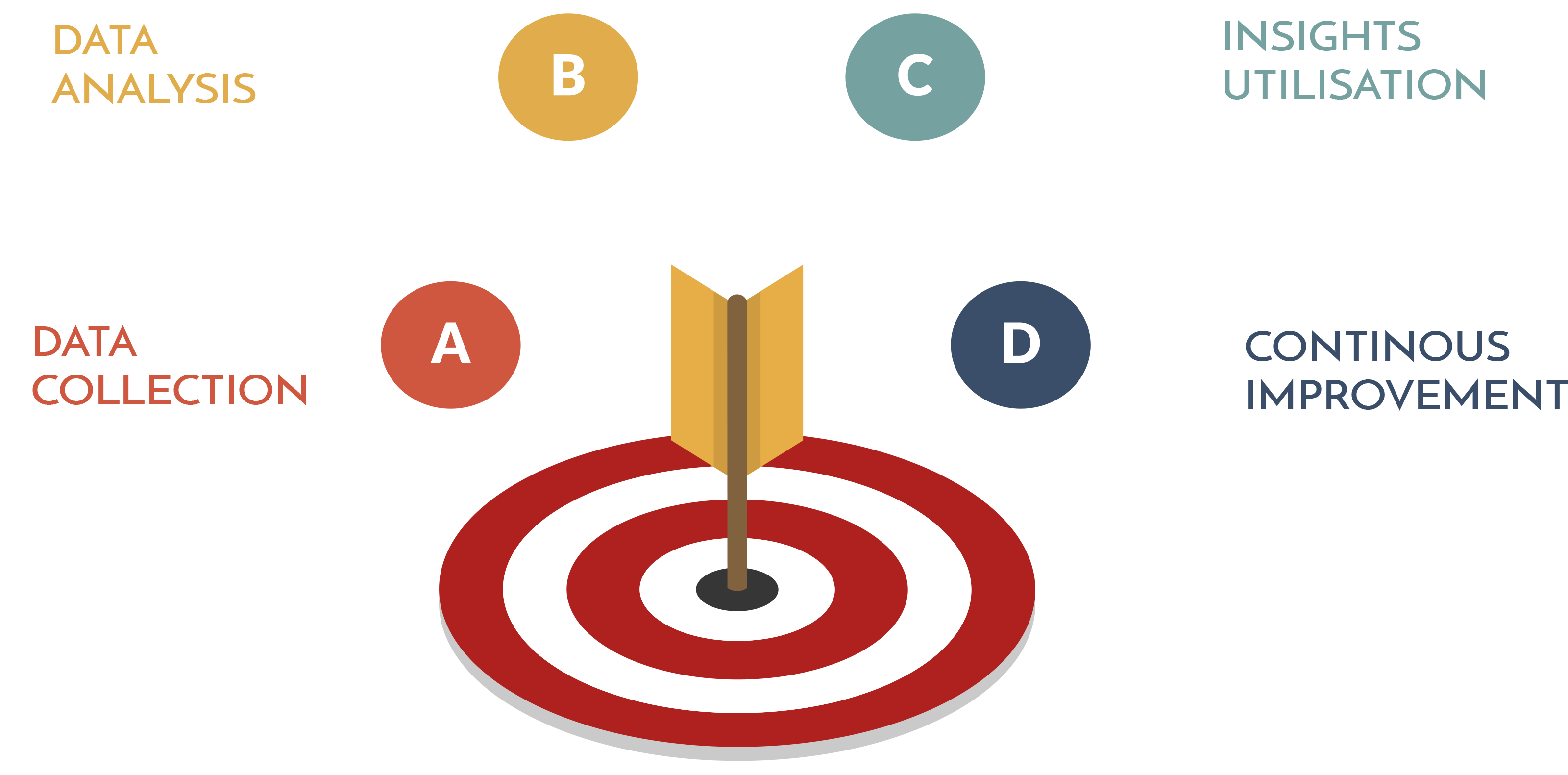
A step-by-step manual for using data to analyse consumer behaviour is provided below:
1. Data Collection:
Data collection, which includes touchpoints like websites, mobile apps, social media, and more, is a crucial source of information that provides a comprehensive picture of client behaviour. It records quantitative indicators as well as qualitative insights, illuminating the “what” and “why” of customer behaviour. Data collection helps customer journey mapping by keeping track of interactions along the customer journey, revealing opportunities and pain spots. It serves as the cornerstone for segmentation tactics by making it possible to identify distinctive patterns within various demographic, psychographic, and behavioural subgroups. Historical data enables firms to forecast future behaviour using predictive analytics.
This knowledge supports personalization initiatives and makes it easier to spot trends and anomalies. Customer happiness and loyalty are measured by metrics like Net Promoter Score, and strategy enhancement through iterative improvement makes use of ongoing data collection. Businesses acquire a solid factual foundation for decision-making, helping them to make wise decisions for engagement, product development, and marketing. Responsible data collecting ensures improved consumer experiences, informed by privacy laws and consent. By comparing findings to those of peers in the industry, competitive analysis further deepens them.
2. Data Analysis:
Understanding client behaviour is based on data analysis, which turns raw data into useful insights. Businesses can identify repeating behaviours, preferences, and engagement patterns through pattern recognition. Data analysis empowers segmentation refinement by enabling the validation and fine-tuning of client segments. Companies can learn more about consumer preferences for products, how people engage with content, and how marketing resonates by examining previous behaviour. Additionally, data analysis provides a comprehensive perspective of the sales process, highlighting drop-off locations and improving conversion optimisation. Predictive analytics, which enables organisations to foresee future behaviour based on historical trends and develop plans catered to specific client preferences, is another application of this analytical prowess.
Data analysis strengthens experimentation and A/B testing and assists in making well-informed decisions. Businesses can address customer complaints and increase happiness by using the insights gained from reviews and customer feedback. The foresight to match marketing and product plans with market dynamics comes from seasonal and trend research. Natural language processing-based sentiment analysis analyses client emotions and opinions to better understand their experiences.
Advanced analytics technologies’ real-time insights give users the flexibility to quickly adjust to changing client behaviour. Businesses are able to recognise areas that are ready for change thanks to the practise of data analysis, which fosters a culture of continuous improvement. To retain customer trust and data compliance, data analysis critically requires moral behaviour and thorough adherence to data privacy legislation. In conclusion, data analysis serves as the compass for organisations, pointing them towards a thorough understanding of consumer behaviour and directing tactics towards superior customisation, engagement, and customer experiences.
3. Insights Utilization:
Utilising insights acts as a crucial link between data analysis and tactical implementation, helping businesses unravel the complex web of customer behaviour. Businesses can gain a better understanding of client preferences, motivations, and interactions by converting extracted insights into effective strategies. A variety of customer-centric strategies, from personalised marketing campaigns to the fine-tuning of product offers, are driven by this informed decision-making. Utilising insights provides plans that are not just pertinent but also deeply felt by a variety of client segments.
The ability to adapt plans to the specific traits of each client group is at the heart of insights utilisation. Businesses may design customer journeys that successfully lead prospects from awareness to conversion while identifying possibilities for optimisation by analysing data patterns and behavioural trends. The importance of insights in churn prevention, where data-driven forecasts assist organisations in identifying at-risk clients and proactively addressing their issues to build loyalty, is equally important.
Moreover, insights utilization sparks innovation in product development. By gleaning a granular view of how customers interact with products, businesses can enhance offerings to align with prevailing preferences. This approach capitalizes on untapped potential, allowing for the introduction of features that resonate deeply with customers.
The proper use of insights is supported by ethical issues, necessitating adherence to data protection laws and customer privacy concerns. Utilising insights effectively positions organisations as custodians of customer trust as well as sellers of goods and services.
4. Continuous Improvement:
A crucial practise that supports firms’ efforts to achieve excellence and relevance in a market that is continually changing is continuous improvement. This iterative method assumes a significant relevance when used to research and comprehend customer behaviour, allowing for deeper insights and a more thorough grasp of customers’ preferences, requirements, and behaviours.
Continuous improvement is fundamentally about encouraging organisations to embrace adaptation and agility. This relates to the capacity to react quickly to developing trends and altering preferences in the context of customer behaviour. Businesses may ensure that their plans are in line with the constantly shifting expectations of their customers by regularly tracking and analysing customer interactions.
A further motivation for firms to embrace agile experimentation is the philosophy of continuous improvement. Companies learn more about how customers react by testing out various techniques, such as marketing campaigns or product variants. This empirical technique offers a useful insight into the behaviour and preferences of various client segments, helping to develop a sophisticated understanding of what resonates with them.
When it comes to client behaviour, the continuous improvement methodology’s iterative learning process is very pertinent. New information and insights are generated with each cycle of strategy and process improvement. These perceptions—obtained from in-person experiences with consumers, their feedback, and behavioural analysis—help us better understand how customers interact with various goods, services, and touchpoints. As a result, over time, the tactics grow more and more honed and customer-focused.
V. CUSTOMER LOYALTY
Customer loyalty is characterized by repeated purchases of products or services from the same brand or company. It reflects the conscious or unconscious preference of the buyer for an offer compared to those of the competition but also his attachment to the brand that offers it.
Retaining customers consists of creating a lasting relationship with them through multiple devices and not just a loyalty program. A successful loyalty process generates many positive effects.
Customer loyalty is the long-term, solid relationship that customers form with a specific brand or company. Customers that repeatedly choose to purchase goods or services from the same business and recommend it to their friends and family are said to be loyal. Building client loyalty is essential for business success since it results in more profitable and less price-sensitive customers, who are therefore a valuable asset for any organisation.
